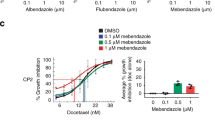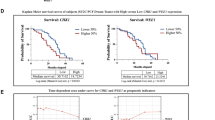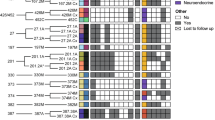Abstract
Preclinical models for the identification of prostate cancer chemoprevention agents are lacking. Based upon the notion that clinically useful chemoprevention agents should exhibit selective activity against early stage disease, studies were undertaken to assess whether chemoprevention agents selectively inhibited the growth of early stage prostate cancer, as compared to late stage cancer. First, a series of cell and molecular studies were performed, which, when taken together, validated the use of a panel of prostate cell lines as a model of the different stages of carcinogenesis. Next, therapeutic responsiveness to ten different cytotoxic or chemoprevention agents was evaluated. Chemoprevention agents exhibited selective activity against normal and early transformed prostate tissue, whereas cytotoxic agents were non-specific. Selective activity against early versus advanced prostate cancer cells is identified as a potential screening method for chemoprevention agents.
This is a preview of subscription content, access via your institution
Access options
Subscribe to this journal
Receive 4 print issues and online access
$259.00 per year
only $64.75 per issue
Buy this article
- Purchase on Springer Link
- Instant access to full article PDF
Prices may be subject to local taxes which are calculated during checkout
Similar content being viewed by others
References
Oesterling JE, Fuks Z, Lee CT, Scher HI. Cancer of the prostate. In: DeVita VT, Hellman S, Rosenberg SA (eds). Cancer: Principals and Practice of Oncology Vol 1 Lippincott-Raven: New York 1997 1322–1385.
Greenlee RT, Murray T, Bolden S, Wingo PA. Cancer Statistics, 2000. CA Cancer J Clin 2000 50 7–33.
Oh WK, Kantoff PW. Management of hormone refractory prostate cancer: current standards and future prospects [see comments]. J Urol 1998 160 1220–1229.
Lara PN Jr, Kung HJ, Gumerlock PH, Meyers FJ. Molecular biology of prostate carcinogenesis. Crit Rev Oncol Hematol 1999 32 197–208.
Sciavolino PJ, Abate-Shen C. Molecular biology of prostate development and prostate cancer. Ann Med 1998 30 357–368.
Carter HB, Piantadosi S, Isaacs JT. Clinical evidence for and implications of the multistep development of prostate cancer. J Urol 1990 143 742–746.
Bostwick DG. Prostatic intraepithelial neoplasia is a risk factor for cancer. Semin Urol Oncol 1999 17 187–198.
Vogelstein B, Kinzler KW. The multistep nature of cancer. Trends Genet 1993 9 138–141.
Bishop JM. Molecular themes in oncogenesis. Cell 1991 64 235–248.
Royai R, Lange PH, Vessella R. Preclinical models of prostate cancer. Semin Oncol 1996 23 35–40.
Kelloff GJ et al Progress in cancer chemoprevention. Ann N Y Acad Sci 1999 889 1–13.
Kozlowski JM et al Metastatic behavior of human tumor cell lines grown in the nude mouse. Cancer Res 1984 44 3522–3529.
Kyle E et al Genistein-induced apoptosis of prostate cancer cells is preceded by a specific decrease in focal adhesion kinase activity. Mol Pharmacol 1997 51 193–200.
Bright RK et al Generation and genetic characterization of immortal human prostate epithelial cell lines derived from primary cancer specimens. Cancer Res 1997 57 995–1002.
Bergan R et al Electroporation of synthetic oligodeoxynucleotides: a novel technique for ex vivo bone marrow purging. Blood 1996 88 731–741.
Schwartz GN et al Growth inhibition of chronic myelogenous leukemia cells by ODN-1, an aptameric inhibitor of p210bcr-abl tyrosine kinase activity. Antisense Nucleic Acid Drug Dev 1998 8 329–339.
Rohlff C et al Growth inhibition of prostate cancer cells by tamoxifen is associated with protein kinase C inhibition and induction of p21 waf1/cip1 Prostate 1998 37 51–59.
Bergan R et al Genistein-stimulated adherence of prostate cancer cells is associated with the binding of focal adhesion kinase to beta-1-integrin. Clin Exp Metastasis 1996 14 389–398.
Bergan R, Connell Y, Fahmy B, Neckers L. Electroporation enhances c-myc antisense oligodeoxynucleotide efficacy. Nucleic Acids Res 1993 21 3567–3573.
Bergan RC, Kyle E, Connell Y, Neckers L. Inhibition of protein-tyrosine kinase activity in intact cells by the aptameric action of oligodeoxynucleotides. Antisense Res Dev 1995 5 33–38.
Bergan R et al Aptameric inhibition of p210bcr-abl tyrosine kinase autophosphorylation by oligodeoxynucleotides of defined sequence and backbone structure. Nucleic Acids Res 1994 22 2150–2154.
Dakhama A, Macek V, Hogg JC, Hegele RG. Amplification of human beta-actin gene by the reverse transcriptase-polymerase chain reaction: implications for assessment of RNA from formalin-fixed, paraffin-embedded material. J Histochem Cytochem 1996 44 1205–1207.
Jaakkola S et al Detection of prostatic cells in peripheral blood: correlation with serum concentrations of prostate-specific antigen [see comments]. Clin Chem 1995 41 182–186.
Culig Z et al DNA sequence of the androgen receptor in prostatic tumor cell lines and tissue specimens assessed by means of the polymerase chain reaction. Prostate 1993 22 11–22.
Roberts AB. Molecular and cell biology of TGF-beta. Miner Electrolyte Metab 1998 24 111–119.
Sporn MB, Roberts AB, Wakefield LM, de Crombrugghe B. Some recent advances in the chemistry and biology of transforming growth factor-beta. J Cell Biol 1987 105 1039–1045.
Webber MM, Bello D, Quader S. Immortalized and tumorigenic adult human prostatic epithelial cell lines: characteristics and applications. Part I. Cell markers and immortalized nontumorigenic cell lines. Prostate 1996 29 386–394.
Peehl DM. Culture of human prostatic epithelial cells. In: RA Freshney (ed). Culture of Epithelial Cells (Culture of Specialized Cells) John Wiley & Sons: New York 1992 159–180.
Webber MM et al Prostate specific antigen and androgen receptor induction and characterization of an immortalized adult human prostatic epithelial cell line Carcinogenesis 1996 17 1641–1646.
Bello D et al Androgen responsive adult human prostatic epithelial cell lines immortalized by human papillomavirus 18. Carcinogenesis 1997 18 1215–1223.
Cussenot O et al Immortalization of human adult normal prostatic epithelial cells by liposomes containing large T-SV40 gene. J Urol 1991 146 881–886.
Weijerman PC et al Lipofection-mediated immortalization of human prostatic epithelial cells of normal and malignant origin using human papillomavirus type 18 DNA. Cancer Res 1994 54 5579–5583.
Mickey DD et al Heterotransplantation of a human prostatic adenocarcinoma cell line in nude mice. Cancer Res 1977 37 4049–4058.
Kaighn ME et al Establishment and characterization of a human prostatic carcinoma cell line (PC-3). Invest Urol 1979 17 16–23.
Jenkins RB, Qian J, Lieber MM, Bostwick DG. Detection of c-myc oncogene amplification and chromosomal anomalies in metastatic prostatic carcinoma by fluorescence in situ hybridization. Cancer Res 1997 57 524–531.
Tremblay L, Aprikian A, Chevalier S. Expression of focal adhesion kinase in prostate cancer. Proc Am Ass Cancer Res 1995 36 64.
Webber MM, Bello D, Quader S. Immortalized and tumorigenic adult human prostatic epithelial cell lines: characteristics and applications. Part 3. Oncogenes, suppressor genes, and applications. Prostate 1997 30 136–142.
Kim IY et al Loss of expression of transforming growth factor β type I and type II receptors correlates with tumor grade in human prostate cancer tissues. Clinical Cancer Res 1996 2 1255–1261.
Sehgal I, Baley PA, Thompson TC. Transforming growth factor betal stimulates contrasting responses in metastatic vs primary mouse prostate cancer-derived cell lines in vitro Cancer Res 1996 56 3359–3365.
Wilding G et al Differential effects of transforming growth factor beta on human prostate cancer cells in vitro Mol Cell Endocrinol 1989 62 79–87.
Steiner MS, Zhou ZZ, Tonb DC, Barrack ER. Expression of transforming growth factor-beta 1 in prostate cancer. Endocrinology 1994 135 2240–2247.
Eastham JA et al Transforming growth factor-beta 1: comparative immunohistochemical localization in human primary and metastatic prostate cancer. Lab Invest 1995 73 628–635.
Tu H, Jacobs SC, Borkowski A, Kyprianou N. Incidence of apoptosis and cell proliferation in prostate cancer: relationship with TGF-beta l and bcl-2 expressing. Int J Cancer 1996 69 357–363.
Perry KT, Anthony CT, Steiner MS. Immunohistochemical localization of TGF beta 1, TGF beta 2, and TGF beta 3 in normal and malignant human prostate. Prostate 1997 33 133–140.
Ablin RJ. A retrospective and prospective overview of prostate-specific antigen. J Cancer Res Clin Oncol 1997 123 583–594.
Culig Z et al Expression, structure, and function of androgen receptor in advanced prostatic carcinoma. Prostate 1998 35 63–70.
Kastan MB. Molecular biology of cancer: the cell cycle. In: DeVita VT, Hellman S, Rosenberg SA (eds). Cancer: Principals and Practice of Oncology 1. Lippincott-Raven: New York 1997 121–134.
Fidler IJ. Molecular biology of cancer: invasion and metastasis. In: DeVita VT, Hellman S, Rosenberg SA (eds). Cancer: Principals and Practice of Oncology 1. Lippincott-Raven Publishers: Philadelphia 1997 135–152.
Bender RA, Hamel E, Hande KR. Plant alkaloids. In: DeVita VT, Hellman S, Rosenberg SA (eds). Cancer Chemotherapy: Principles and Practice JB Lippincott: Philadelphia 1990 253–275.
Myers CE, Chabner BA. Anthracyclines. In: DeVita VT, Hellman S, Rosenberg SA (eds). Cancer Chemotherapy: Principles and Practice JB Lippincott: Philadelphia 1990 357–381.
NIH Development. Clinical development plan: 1-perillyl alcohol. J Cell Biochem 1996 26 137–148.
Stewart CF, Ratain MJ. Topoisomerase interactive agents. In: DeVita VT, Hellman S, Rosenberg SA (eds). Cancer: Principals and Practice of Oncology 1. Lippincott-Raven: New York 1997 452–467.
Rowinsky EK, Donehower RC. Antimicrotubule agents. In: DeVita VT, Hellman S, Rosenberg SA (eds). Cancer: Principals and Practice of Oncology 1. Lippincott-Raven: New York 1997 467–482.
Steele VE, Pereira MA, Sigman CC, Kelloff GJ. Cancer chemoprevention agent development strategies for genistein. J Nutr 1995 125 (Suppl 3): 713S–716S.
Bergan RC et al A phase II study of high dose tamoxifen in patients with hormone refractory prostate cancer. Clinical Cancer Research 1999 5 2366–2373.
Author information
Authors and Affiliations
Rights and permissions
About this article
Cite this article
Liu, Y., Kyle, E., Patel, S. et al. Prostate cancer chemoprevention agents exhibit selective activity against early stage prostate cancer cells. Prostate Cancer Prostatic Dis 4, 81–91 (2001). https://doi.org/10.1038/sj.pcan.4500506
Received:
Accepted:
Published:
Issue Date:
DOI: https://doi.org/10.1038/sj.pcan.4500506
Keywords
This article is cited by
-
FOXA1 inhibits hypoxia programs through transcriptional repression of HIF1A
Oncogene (2022)
-
Lévy-like movement patterns of metastatic cancer cells revealed in microfabricated systems and implicated in vivo
Nature Communications (2018)
-
Precision therapeutic targeting of human cancer cell motility
Nature Communications (2018)
-
Endoglin suppresses human prostate cancer metastasis
Clinical & Experimental Metastasis (2011)
-
Inhibition of cancer cell invasion and metastasis by genistein
Cancer and Metastasis Reviews (2010)



